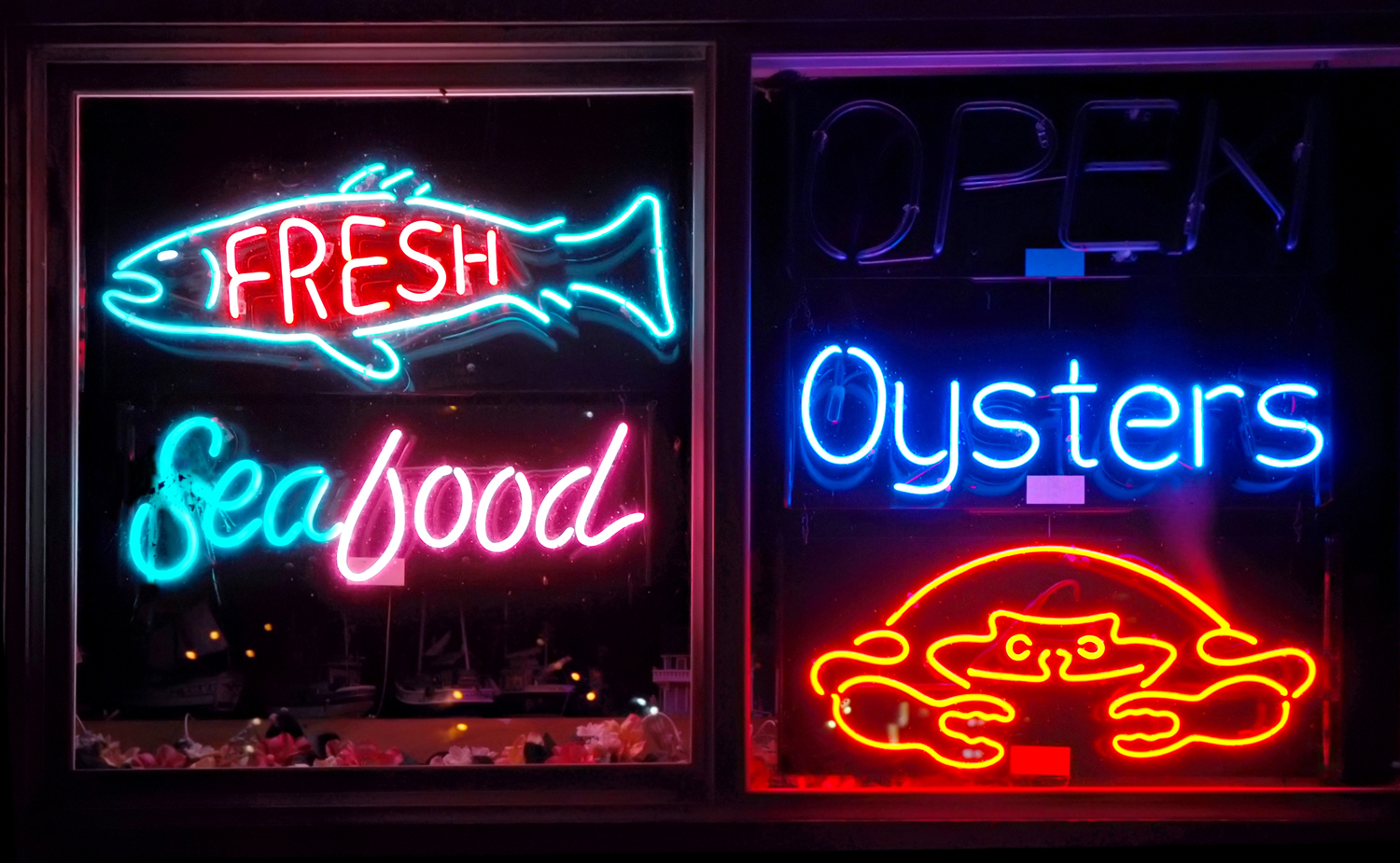Many sign people new to the industry associate electric signs with digital message boards or LED-lit boxes. Maybe some remember from childhood that there was something called “neon,” and not only to create “retro” designs. But many customers who want a unique sign today often ask a shop, “Can you do that in neon?” So, here I will explain some basics you should know – and some necessary steps for working with neon.
In short, a neon sign consists of one or more neon tubes and additional elements (structural and electrical). Every neon tube is a custom, hand-made electric lamp with particular properties, fabricated in a special neon glass shop (most sign companies now outsource glasswork to specialized shops).
Neon tubes are essentially linear light sources (in contrast to the point light of LED) made out of glass tubing, the only material capable of with-standing the operating conditions inside. The glass tube can be bent into almost any shape. As with every electric lamp, it requires two electrical connections – electrodes – to become part of a closed electrical circuit. The electrodes are not luminous and fill roughly 1-2 in. at the ends, but the glass tube can be bent in a way that these electrodes are practically invisible.
Neon tubes can be made to light in one of many colors; the final color (or spectrum) of the emitted light is created by the combination of the gas fill, eventually a fluorescent coating on the inside of the glass tube and maybe the use of colored glass acting as light filter. Every ionized gas lights in a characteristic color. Pure neon gas emits a reddish light, while fluorescent coatings on the inside of the glass tube and colored glass or different gases create other colors. Some (red, blue and pinkish-white) can be made in clear glass so that the tube is practically invisible when not in operation – an advantage for some designs (such as the window-hanging sign shown above).
As the electrical current flows through the gas inside the glass tube – always embarking on the shortest path – the glass tube between the two electrodes must remain a single, continuous path for the current, without forks or dead-end sidearms. Thus, while a block character “L” is simple, an “O” cannot be closed and must be made like a “C” with adjacent ends and a small gap.
To execute a more-complicated “E” in a single piece, the tube starts with the bottom line, then the first half of the vertical stroke, then into the center horizontal line up to the end. There, the tube is bent back 180° exactly behind the center line – and thus invisible up to the point where the vertical stroke turns and continues to the top. Finally, the tube is bent back to the front and continues as the vertical, upper part before terminating to the right, as in the illustration above.
Advertisement

Also, with smaller size text (up to 8 in. high) it is common not to make each character a separate tube, but to connect the characters (as in hand-written script). However, to make the interconnections invisible, they are painted black and called “blocked-out sections.”
Normally, the exact tube layout is created with the neon glass shop so that the glass shop will know the total stretched length of the neon tube. From the length and number of tubes, the electrical parts required are dimensioned; the size, weight and placement determine the structural design of the sign’s body.
As neon tubes are unique, the power supply must be matched to the tube – “one size fits all” does not apply here. The tube length, diameter (the smaller, the more restricted the electrical flow) and the type of filling gas (depending on the color) are the parameters necessary to calculate the correct power supply. Neon power supplies can be “core and coil” transformers or electronic power supplies.
In contrast to LEDs, which work at a low voltage (commonly 12 or 24 V) and high currents of several amperes of direct current, neon tubes operate at higher voltages (a blue, 4-ft.-long tube of 15mm diameter takes 742 V to light) and lower amounts of alternating current (a standard operating current for neon is 0.025 amps only).
Electronic transformers put out alternating current at high frequency, which limits their use to dry, indoor conditions (water would drain the high frequency currents to earth), so core and coil transformers are the way to go for outdoor signs. They are larger and heavier, but much sturdier than their electronic pendants – something to consider when designing the sign structure. Transformer manufacturers provide charts for easily estimating the matched trans-former size and type to a given set of tube lengths/diameters.
Advertisement
High voltage needed in neon signs requires different installation/mounting than low voltage LEDs. The neon tubes can be connected to the high voltage cable (called “GTO”) either by twisting or via push-in connectors called “housings” mounted on the sign faceplate. For good references in correct electrical installation of neon signs, consult the books Neon Lighting of the International Association of Electrical Inspectors (IAEI), and Neon Techniques, 4th Edition, edited by Wayne Strattman (ST Books).
Transforming text into neon signs is like writing with a pen – drawing lines of light. Transforming a company logo into a fresh neon sign design takes qualities of a cartoonist, because expressing the major characteristics with only a few lines of light is paramount.
No less important is the designer’s knowledge about the technical requirements of a neon sign. For example, the stroke width is given by the glass tube diameter ranging from 8-18 mm (in Europe to 25 or 38mm is common). Joining sections of different diameters within a single neon tube is very uncommon, whereas joining sections of different colors is possible (within limits given by a common type of fill gas).
So, can you “do that” in neon? Chances are, you can.



 Tip Sheet1 week ago
Tip Sheet1 week ago
 Photo Gallery3 days ago
Photo Gallery3 days ago
 Ask Signs of the Times5 days ago
Ask Signs of the Times5 days ago
 Real Deal2 weeks ago
Real Deal2 weeks ago
 Benchmarks1 week ago
Benchmarks1 week ago
 Paula Fargo11 hours ago
Paula Fargo11 hours ago
 Photo Gallery11 hours ago
Photo Gallery11 hours ago
 Women in Signs2 weeks ago
Women in Signs2 weeks ago








